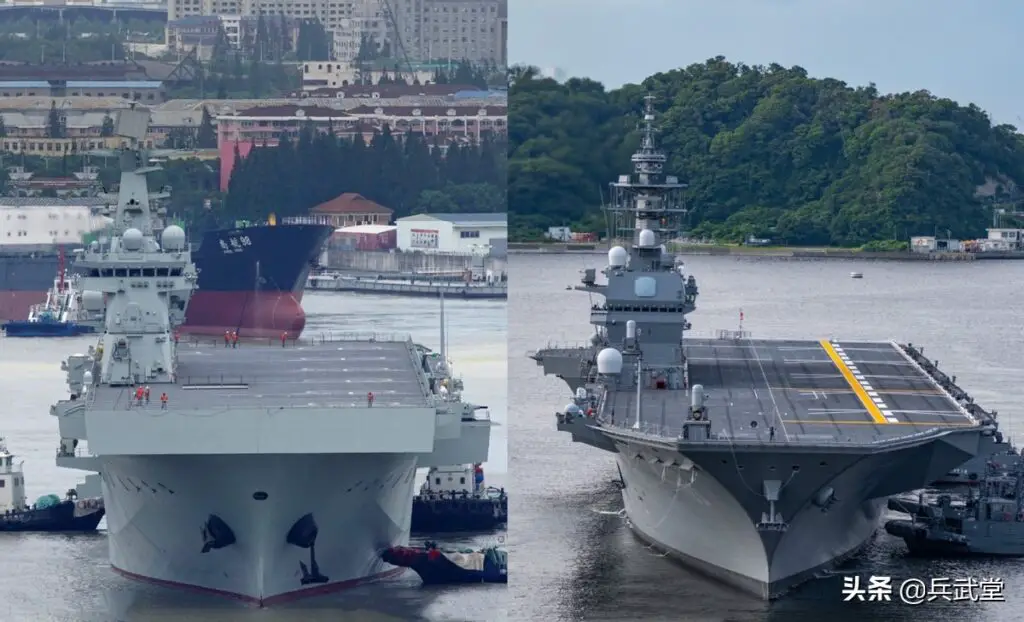Japan will have two aircraft carriers by 2027. On 4th April, the press service of the Japanese Navy announced that the JS Kaga helicopter carrier was at the first stage of conversion at the dock in Kure (Hiroshima Prefecture).
The re-equipment of the ship will take place in two stages. The first should be completed in 2023, and the second – by 2027. After completion of all work, JS Kaga will become an aircraft carrier and will be able to operate with F-35B Lightning II VTOL fighters fully.
Japan is one of the countries participating in the F-35 fighter development program and is purchasing a modification of the F-35A for its Air Force. Rumours about Japan’s plans to convert its Izumo-class helicopter carriers into light aircraft carriers have been around for a long time, and in 2018 there was information about the Japanese government’s official intention to purchase F-35B fighters to form an air wing for these ships. After that, the re-equipment of the JS Izumo ship began.
The first ship of the Hyūga-class helicopter carrier was laid down in 2011 and entered service on 23rd March 2015. Ships of this type are almost 250 m long, about 40 m wide and capable of speeds up to 30 knots. The ship’s crew consists of 470 people, while an additional 500 paratroopers can be accommodated onboard. The air wing consists of 9 helicopters, but a maximum of 28 aircraft (helicopters, convertiplanes, fighters) can be placed on each ship.
Japan’s Helicopter carriers
On 25th March 2015, the Kyodo News news agency reported that a new Izumo helicopter carrier (design index – DDH183) with 27,000 tons was built and put into operation in Japan. This ship became the largest combat ship of the Japanese Maritime Self-Defense Forces.
“Izumo” (destroyer-helicopter carrier type “Hyuga”) was laid down in January 2012 of the year in Yokohama and launched from the yard of IHI Marine United in August 2013. It became the third and largest destroyer of this series (helicopter carriers “Hyuga” and “Ise” were already serving in the fleet, and one more, the fourth in a row, was to be put into operation before 2018. According to the plan of the Ministry of Defense of Japan, helicopter carriers would form the basis of the country’s anti-submarine defense.

Although there are assurances from the country’s leadership that Izumo is not an aircraft carrier, since it will not have fighter aircraft on board, the ship’s dimensions allowed it to be used as a floating airfield. In this sense, ships of this class can be recognized as the first aircraft carriers built by Japan since World War II.
The ship got its name in honour of the historical province of Izumo and in memory of the legendary cruiser Izumo, which took part in the Russo-Japanese, First and Second World Wars. In the famous Battle of Tsushima, the cruiser received 12 hits but remained afloat and ended her combat career only in 1945, sinking after an American bomber raid. Two other helicopter carriers are also named after Japanese warships that sunk in World War II – Hyuga and Ise’s eponymous battleships. It is a remarkable historical fact that both of these battleships were hastily converted into aircraft carriers (in fact, into aircraft-carrying battleships) during the Pacific War to keep up with rapidly changing naval tactics.
The Izumo helicopter carrier could carry seven anti-submarine and two search and rescue helicopters, and five rotorcraft could be accommodated on the deck, take off, and land simultaneously. The Ministry of Defense of Japan announced its intention to use Osprey MV-22 convertiplanes on the new ship, which are modern American-made aircraft, a hybrid of an aeroplane and a helicopter. Due to the rotary planes of the supporting wings, on which the propellers are located, tiltrotors combine the convenience of vertical takeoff and landing and, turning the aircraft 90 degrees on the go, turn into a turboprop aircraft right in flight.
At the solemn ceremony of accepting the Izumo into the Japanese fleet, Defense Minister Gen Nakatani announced that the new helicopter carrier would participate in peacekeeping and maritime safety and international rescue operations.
JS Kaga was inducted into the navy in August 2015.
As Japan continued to balance between a pacifist constitution and the development of its armed forces, on 9th December 2018, the media reported that the Japanese government had changed the purpose of the Kaga and Izumo ships.
The ships are being modified to withstand the heat blast of the fighter aircraft and storage hangers.
